كثيرا ما تغني أضواء واضحة تطال البلاد وتزدهر أبيض البنايات التي تتسلق إلى التل وتسمى “الجزائر العاصمة الأبيض”. وهذا الاسم يجعل المدينة المتحركة العظيمة أقرب إلى البحر الأبيض المتوسط وتدير ظهرها إلى الصحراء بين المغرب وتونس.
فالجزائر العاصمة واحدة من أكبر وأغنى الدول في أفريقيا. وتنقسم المدينة إلى منطقتين: العصرية المتحركة على الساحل والثانى القديم “كاسبة” المدينة القديمة سقطت على قمة تلة على إرتفاع 120 متر
إذا قررتم يوما ما القدوم لزيارة هذه المدينة الجميلة، هذه هي الأشياء المهمة التي يجب عليكم أن تفعلوها:
1 – نصب الشهيد التذكاري وهو موقع رائع للذاكرة الوطنية.
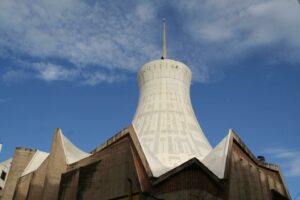
بدأنا رحلتنا مع نصب الشهيد أو مقم إشهيد أحد أكثر الآثار المعروفة خلال زيارة الجزائر العاصمة والذي بني عام 1982 بالقرب من حديقة التجارب في الحامة بمناسبة الذكرى العشرين لاستقلال تيمور الشرقية وهو مخصص للمقاتلين السابقين في حرب المجر. وهو مكون من ثلاث قوالب منحازة تتواءم مع بعضها البعض طراز متوسط الارتفاع بالكامل.
وتحتفل حركة مجاهد باسم متحف المجاهد الوطني تحت النصب التذكاري. البانوراما الجميلة حول الخليج والأحياء الجنوبية تنبثق منك من البالوستراد في أعلى طريق عمر كيشكار.
إن هذا النصب التذكاري يشكل أهمية كبرى بالنسبة للشعب الجزائري ويعتبره راعي مدينة الجزائر
واذا نظرت إلى طريق الضريح انها مغامرة في حد ذاتها مع مشاهد لا تصدق طرق من خلال الجبال وجمال طبيعي رائع لن يجعلك تشعر بالملل
لا يمكنك ان توقف نفسك وان تنظر إلى هذا النصب التذكاري الرائع لدقائق معدودة إنه مكان للزيارة في عاصمتنا
2 – القصابة
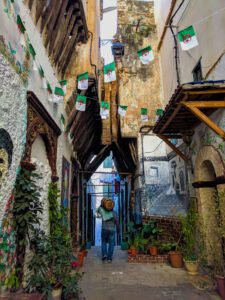
قصبة تعني القلعة هذا هو الحي الأثري في الجزائر العاصمة التي صنفت المدينة القديمة باعتبارها التراث العالمي لليونسكو. يمكنك التجول في الزقاق بين المنازل حتى تختبئ في بعض الأحيان كنوز مخفية. في القصبة سوف تجدون أجمل مساجد المدينة. محاطة القصبة قلعة بنيت في القرن السادس عشر. سيدرسا (مدارس) وضربا ستكون في مركز زيارتك يمكنك قضاء يوم واحد بسهولة.
3 – قصر دار عزيزة وجنينا
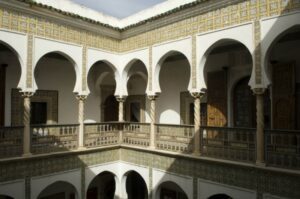
في قصبة أيضا دار عزيزة قصر في ساحة الشهداء. يقع بالقرب من مسجد كيشاوا كما هو معتاد في البيوت الجليدية في القرن السادس عشر. كان ذلك في الماضي محل إقامة العرش في الجزائر. وعلى الرغم من أنه مغلق رسميا أمام الجمهور فإن الوصول إلى الدورات الدراسية قد يكون ممكنا في بعض الأحيان حسب رغبة الحارس.
هناك نسختين من تاريخ هذا المنزل الجميل.
ان أكثر الادلة شهرة هي ان در عزيزة تأسست في القرن السادس عشر بناء على أوامر من ابنته عزيزة التي تمد يدها إلى قسنطينة باي. وقد ذكر هنري كلاين هذه الحقائق دون ذكر أسماء الدول ذات السيادة المعنية أو التواريخ الدقيقة لهذه الأحداث.
وهناك نسخة أخرى أكثر تحديدا جاء بها أوجين فيستس تقول إن عزيزة ابنة القائد أحمد بن رمضان وشقيقة شيلبي بن علي بيتشين تزوجت في المقام الأول برحيل بن فرحات من قسنطينة ثم عادت إلى شقيقها رجب باي. أحبته المرأة الأخيرة كثيرا حتى أنها أخذته إلى مدينة الجزائر حيث إحتفلوا بالزواج الكبير. فقد بنى في نظره قصر أصبح فيما بعد محل إقامة ثانوية لعائلة قسنطينة عندما سافروا إلى الجزائر لسداد الضرائب التي تحملونها.
قصر جينا هو أقدم قصر في الجزائر. كان هذا هو مركز القوة حتى عام 1817. وقد دمرت النيران في عام 1844 إلا أجزاء منها دار عزيزة.
4 – منتزه هاما
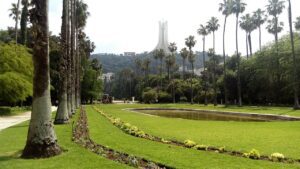
حديقة التجارب في حممة في حي مدينة الجزائر العاصمة هي متنزه لوكسمبورغي يقع في سهول المسرح الوطني للفنون الجميلة في الجزائر من شارع محمد بلوزداد إلى شارع حسيبة بن بوعلي الذي يمتد على 58 هكتارا
وقد أنشئت في عام 1832 وتعتبر واحدة من أكبر منتزهات التجريب والترفيه في العالم.
متنزه التجربة ليس فقط مركز للزراعات أو البستنة بل أيضا مركز تربوي ونزهات يحظى بتقدير كبير من سكان الجزيرة. هناك أكثر من 1200 نوع من النباتات.
المتنزه تجمع أخضر على محور مكعب الشهيد على الساحل الجزائري ومتحف وطني للفنون الجميلة. وهي محاطة بشارع حسيبة بن بوعلي والخليج الشمالي وشارع بلوزداد جنوب الملعب في 20 آب/أغسطس 1955 في الشرق وبالقرننة في حماة في الغرب الذي يضم فندق سوفيل والمكتبة الوطنية.
الجناح الغربي للحديقة الفرنسية وشوارع واشنطن. وهو منفصل عن متنزه سيكامور هاتونغ القديم على الطريق مثل لونغتشو هتونغ وبانيان هوتنغ وبطوله بعدة طرق متوازية على الطريق من بامبو لين وبلام لين. طريق دائري جنوبا شرق كوكونو آلي يدور حول حديقة إنجليزية مع بحيرة صغيرة من النباتات المائية
ويحيق الزوار بشكل خاص التغيرات التي تطرأ على حدائق العالم من المنتزهات الفرنسية إلى الحدائق الصغيرة في فرنسا التي تقدم بانوراما فريدة للبحار والحدائق الأخرى مع حيزات من النباتات الاستوائية والقنافذ والطيور الزخرفة إلى عالم نباتي غير معروف في خطوط العرض تلك
وفي الطرف الشمالي من ناجارجونة – هوتنغ توجد حديقة حيوانات تجمع عينات من الحيوانات في شمال أفريقيا وبعض الحيوانات البرية
5- كنيسة: سيدة أفريقيا
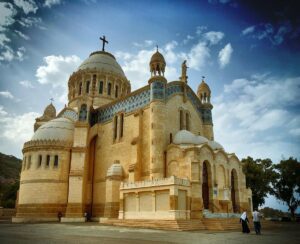
بعد 14 عاما من العمل أنجزت الكاتدرائية عام 1872. المهندس المعماري جان أوجين فرومغو بني من الناحية البيزنطية وأعاد بناءه من القبة. ولكن خطته تشير إلى أن صعق الحلق يقع في الجنوب الغربي (وليس في الجزء المعتاد). وهي بنيت على طريق يبعد 124 مترا شمال الجزائر على مستوى البحر ويمكن الوصول إليها عبر الهاتف من بولكين (سانت أوجين سابقا).
وهذه الكنيسة الكاثوليكية العظيمة على الساحل الجزائري على إرتفاع 125 مترا تقريبا. تم بناؤه في القرن التاسع عشر بواسطة المهندس الفرنسي جان-أوجين فروماجيوت في فرنسا عبر الزمن. كثيرا ما ينظر إليها باعتبارها “أختا توأم كنيسة سيدة مارسيليا نوتردام”. ” انها تعمل بالفرنسية يوميا ولكن العديد من السياح الذين يأتون هنا للاحتفال بالعمارة ووجهات النظر المذهلة
6 – المتحف الوطني للفنون الجميلة
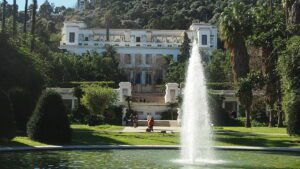
في مواجهة حريق خليج الجزائر الشهير على تلة سانغلار، الذي يحكمه سلسلة من بذور “حدائق العصر”، بدأ المتحف الوطني للفنون الجميلة الذي أنشأه المهندس الفرنسي بول جون المولود في الجزائر العاصمة في عام 1927 ثم فتح أبوابه في عام 1930. مبناه من أربعة طوابق في 1931 هو مزيج من النماذج، التأثيرات الزخرفية للفنون الإسلامية في القرون الوسطى مثل الفن القديم أو الأشكال الإبداعية للفن القديم. وهي أكبر مجموعة فنية في الجزائر والعالم العربي بل وحتى القارة الأفريقية تضم 8000 قطعة.
كما تشمل اللوحات (الرحلة الحقيقية لستة قرون من تاريخ الفن العالمي) والرسم والرسم والنقوش والقوالب القديمة والنحوتات والفنون الجميلة والأثاث القديمة والفنون الزخرفية والرعوي والرسام الكاريكاتيري ذات الصلة بالمجموعة.
يحتل الفن العربي مرتبة عالية في هذا العدد الكبير من الناس بما في ذلك أقدم الأعمال الفنية في الجزائر.
كما صمم المتحف الوطني للفنون الجميلة منحوتة خارجية مخصصة: في رحلة إيطالية، طريقة ممتازة للسير لرؤية المنحوتات على الشرفة في الطابق الأرضي، التاريخ يرسم تاريخ النحت في العالم.
7 – كاتدرائية القلب المقدس في الجزائر العاصمة

كاتدرائية القلب المقدس معروفة ببناتها الحداثة. وقد بنيت في عام 1962 إستجابة لرغبات المونس لينو في عام 1944 والمونجي دوفال في عام 1958.
وقد بنيت على أساس خطط بول هيربي جين لوتور لتحل محل كاتدرائية القديس فيليب التي عادت إلى العبادة الإسلامية في الاستقلال.
إن “البرج” الزائدي يبلغ طوله 35 مترا. الداخل لا يصدق. فوق القبة يوجد صخرة ترنم على أربع أقواس خرسانية مربوطة بثمانية أعمدة. إن لعبة الخط واستخدام الخرسانة تستحضر تماما فكرة خيمة الرب في إنجيل القديس يوحنا الذي صممه مهندسو بول العشب وجان ليكورت.
وقد عرضت هذه السجادة لويس فيليب في كنيسة القديس فيليب. تم إرسال صناديق البربر إلى الكاتدرائية من قبل رهبان تيبيريم قبل 11 يوما من إختطافهم واغتيالهم. أما مذبح كرارا الذي يبلغ طوله 6 أطنان فيتأوي رقائق القديسين الأفارقة فيكتور وفالكنز.
وكانت المنصة هدية من نابليون الثالث وكان الثنائي ملك لتجار ستويلي. وأعمدة الرخام الأصلية تأتي من كنيسة تامنتفوست. ورابعا من هذا الصنف كانت أساطيل 324 من الكاتدرائية الأولى في كاستروم تينغتنوم (Chlef، Evansville). هذه غرفة فريدة للفن المسيحي القديم لأنها ستكون أقدم ممثلة لكنيسة على شكل متاهة. الأرغن كان هدية من (بوفاليك) الزورق هو قائد أعمال السيد (هنري مارتن غرانيل)
8 – متحف باردو الوطني
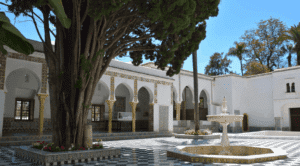
وهو مكان فريد مليء بالتاريخ والتقاليد تم بناؤه في نهاية القرن الثامن عشر ويقع في وسط مدينة الجزائر. كان المبنى الذي تم تسجيله في المعالم التاريخية عام 1985 محل إقامة في الأصل لمشاهير من بينهم الأمير هاكسي في المنفى ومنذ عام 1930 بوصفه متحف لما قبل التاريخ والأعراق.
100 – وتشمل مجموعة المتحف مجموعة من المنتجات الحبرية والنيولية بما في ذلك التماثيل والأشياء الصيادين وبيض الرمال المحولة إلى قوارير. لكن النواة تظل هي القبر الذي يعود إلى القرن الرابع والهياكل العظمية للملكة الأسطورية أوكتواريج تين هينان. وقد عثر عليهم في وسط قبر في أباليسا وأباليسا وكان لديهم عملات من قسطنطين الأكبر تتضمن مجوهرات ذهبية وفضية وأثاث جنازة.
كما يوجد في المتحف مجموعة من الصور العرقية تشمل آلات الموسيقى والأسلحة والملابس الغنية والمجوهرات والأثاث التقليدي.
وبالإضافة إلى المعارض العرقية الدائمة والتاريخية يقوم المتحف الوطني في باردو أيضا بتنظيم معارض مؤقتة وأنشطة تعليمية لتوعية الجمهور بالتاريخ والتراث.
9- مساجد القصيبة
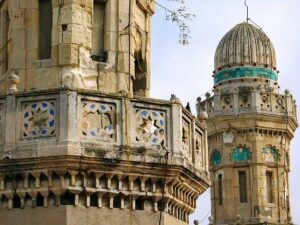
ومن بين مساجد قصبة الجزائر العاصمة جمعة كمشاوة وجمعة الكبيرة الكبيرة وجديد وجديد وجمعة علي بيتشين وجمعة سيدي رمضان وجمعة سيدي محمد شريف وجمعة البرني وجمعة صافر وجمعة حفيد.
المسجد الأقدم في القصبة في الجزائر هو جامع الكبير الذي شيد عام 1097 بواسطة يوسف بن تاشفين على نمط المحرم. وقد بنيت في وقت كان فيه المغرب يشعر بتأثير الفن الأندلسي. أكبر خاصية في هذا المسجد هي صالة صلاة ومنية. تتمركز صالة هيبوستيل في أعمدة قوية مرتبطة بأعمدة كبيرة مرصعة، قبعات الأعشاب والضباب مسطحة ومبنية. وقد غطى المر أعمدة وخزفية.
ترنجان ترنجان الذي استخدمه سلطان رمضان في تلمسان في عام 1324 والذي كان يستخدم فلاندرز على القمة .. وهو مصنوع من السيراميك وبنحات نحيفة إن المعرض الخارجي ليس منشئا فهو مكون من أعمدة رخام ورخام من حروف كبيرة من مسجد السيدة الذي كان في السابق يقع في ساحة الشهداء وهدم الحقبة الاستعمارية
10 – قصر رايس
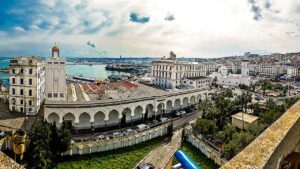
بدأت قصة القصر ببناء مدينة برج الزوبيا بواسطة دي رمضان باشا عام 1576 لتعزيز دفاعات المدينة السفلى. وهو يحمل اسم وادي الأسسور (أسفل الردهة) وسيبا تيبارين (سبعة رجال) وتوبانيت أرناوت بسبب المدفعية التي شنها رايس مامي أرناوت. يطلق على فورت 23 اسم بناء جدران المدينة الفرنسية. وعلى النقيض من هذا فإن أرقام القصر المعينين (القصر رقم 16 والقصر رقم 17 إلخ) ودور “الصيادين” هي مهام تقع في نفس الفترة. تم تجديد القاعدة 23 على نحو جيد وسهل الوصول إليه






